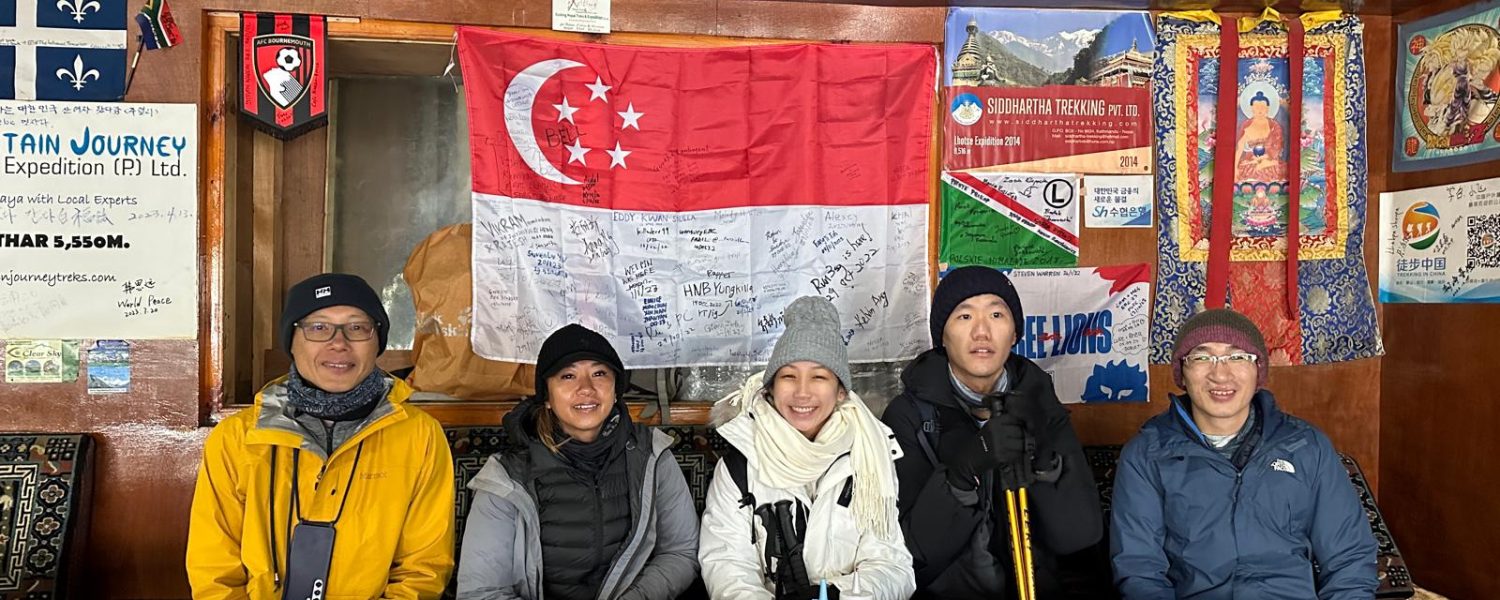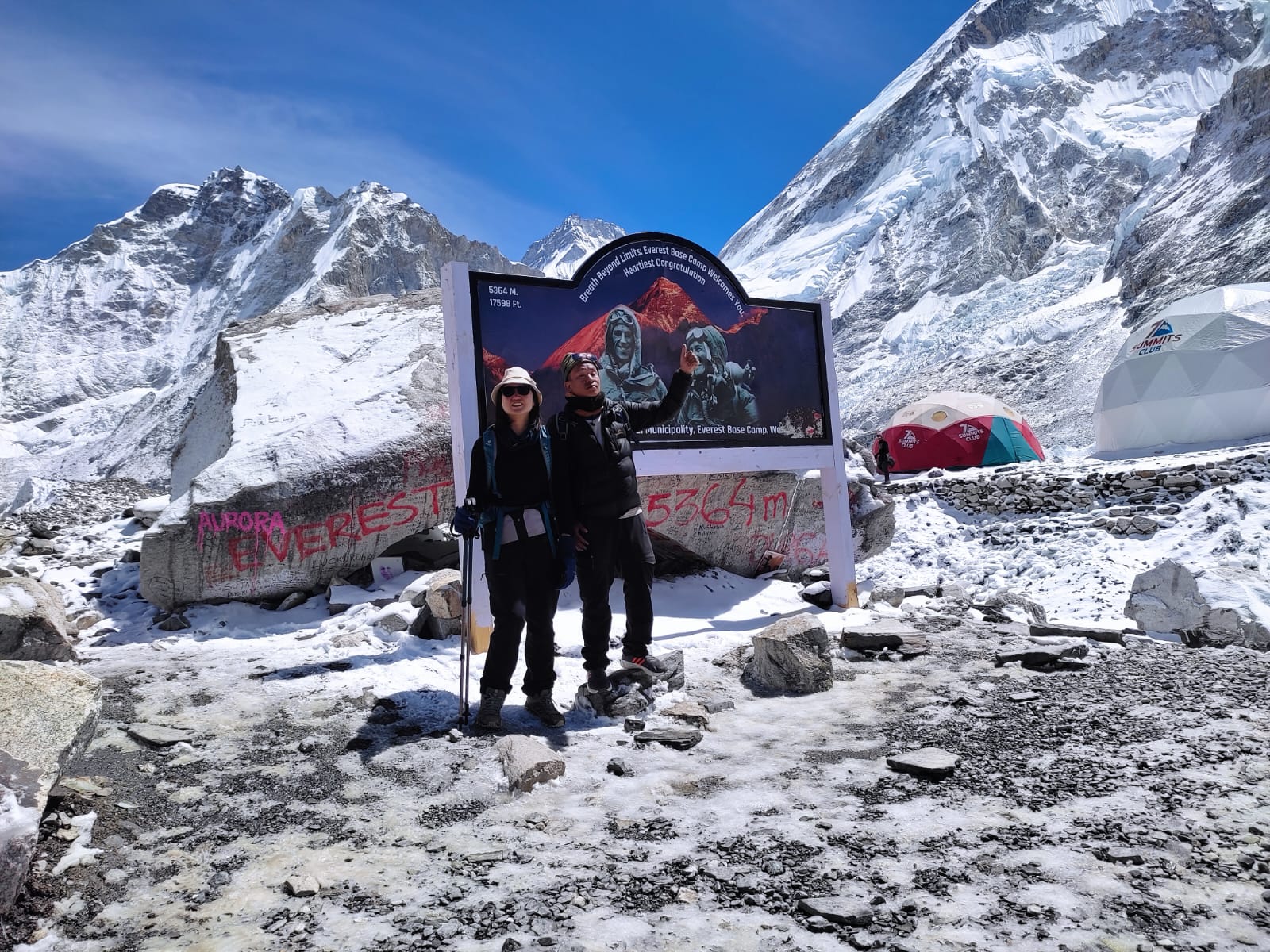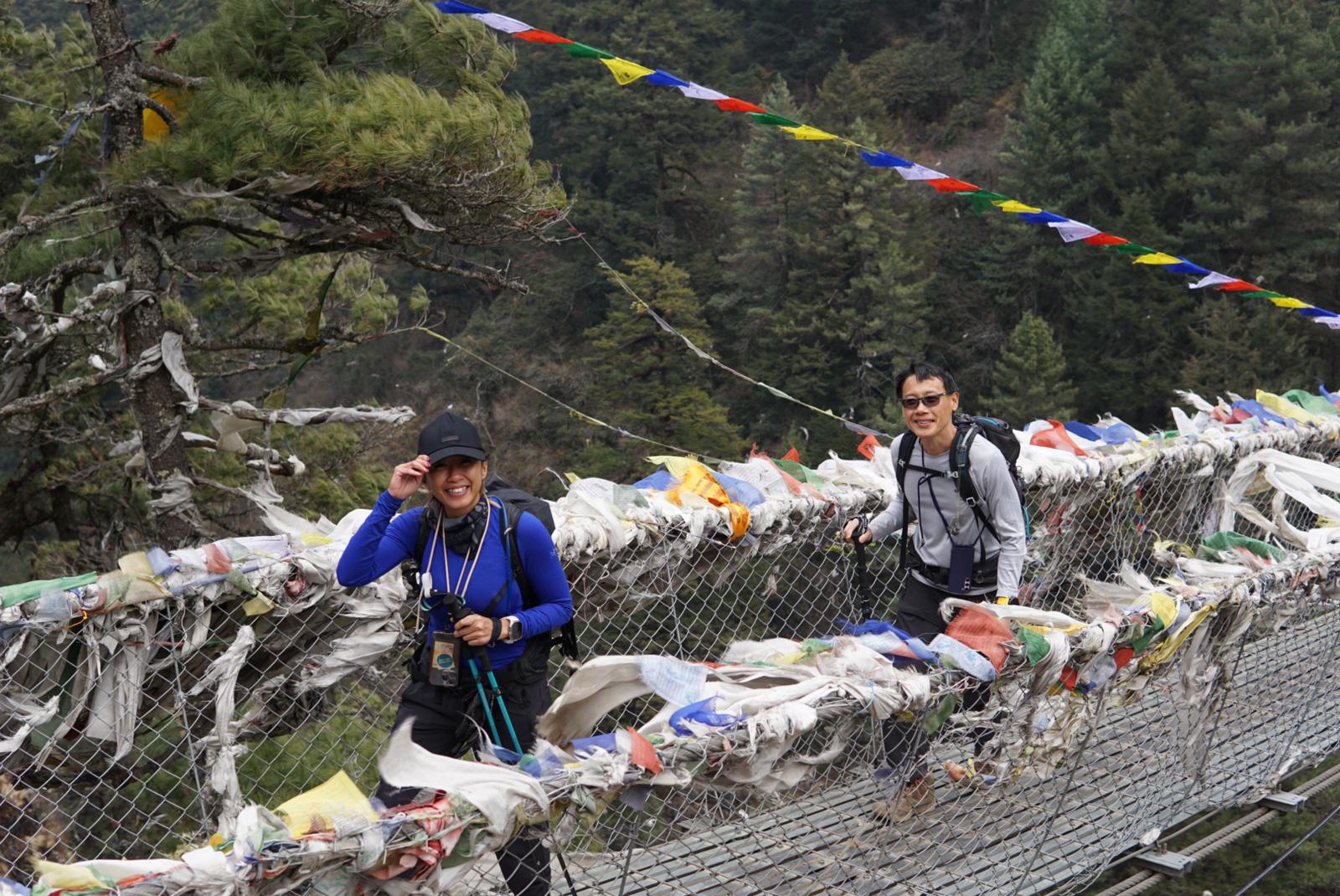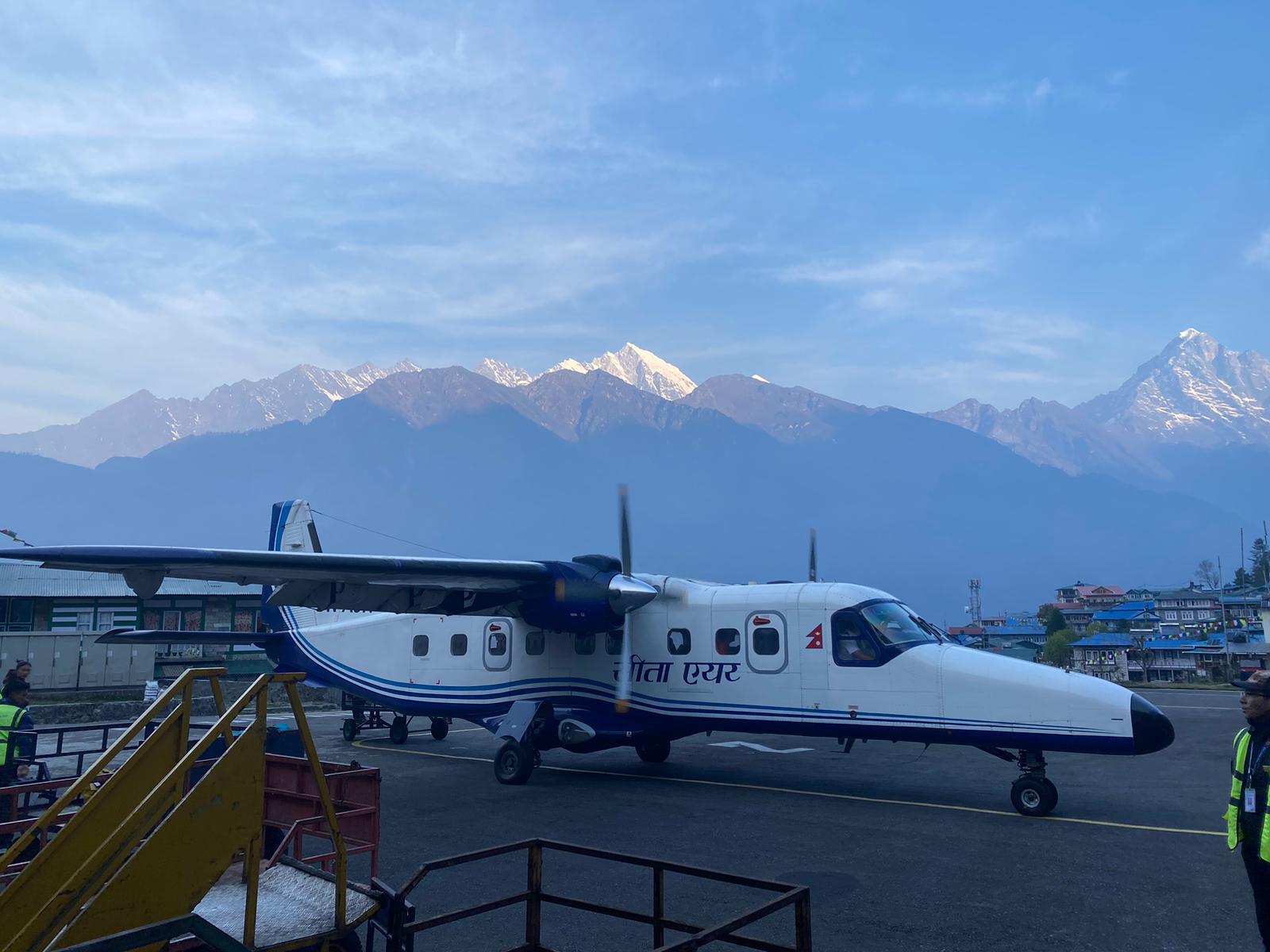Everest Trekking Season and weather conditions, The Spring Season Months of March, April, and May, And the Autumn Season, Months of September, October, November, and December are the Best Trekking seasons and perfect weather In The Everest Region!
Trekking to Everest in the Spring season:
The Everest trekking Season, A great highland adventure in Sagarmatha National Park, a globally significant place, is trekking to Everest Base Camp. Admire the breathtaking views of the more than 8000-meter peaks, including the summit of Everest, the tallest mountain in the world, as you travel through the high-altitude environment.
A mind-blowing adventure experience full of wonders is trekking to Everest Base Camp. Learning more about the Sherpa people and their fascinating culture might be facilitated by following the right trekking schedule in the Khumbu region.
By miracle, the whole Everest region is now accessible from Kathmandu’s domestic airport by a short Himalayan flight from Lukla. Many feet are itching for the amazing journey down the historical path discovered by the world pioneer.
You may visit Mount Everest’s base camp with the Base Camp of Everest Trek, an amazing adventure trekking trip. This path offers views of eight thousand-meter Lhotse, Everest, and many other peaks, such as Thamserku and AmaDablam. Trekking with this picturesque peak in the Everest region is satisfying. But this hike is lovely because of the range of people and societies it passes by—it’s not just about the mountains.
The Everest base camp walk is definitely a once-in-a-lifetime experience that everyone should do, as it will take you past gorgeous Sherpa cultural towns, glacial rivers, and breathtaking vegetation. Everest is a great place to trek, and you’ll definitely learn a lot about living vertically while admiring some of the most beautiful landscapes on Earth.
In addition, Pangboche and Tengboche offer true peace and comfort. Above that point, the entire trail is shaded by the Gokyo range and other high mountains in the Everest Himalayan group.
Spring breaks the monotony of Winter and brings in a new beginning. As you hike, the gorgeous colors and blossoms of this season will catch your eye. The trail is heavily used by hikers and tourists at this time of year. The rhododendron, or laligurans, is Nepal’s national flower and blooms in the springtime throughout the Everest Region. At this time of year, traveling through the “Sagarmatha National Park,” a UNESCO World Heritage site, offers sights of wildlife, birds, and vegetation. The region pauses in the thin air before altitude mountain sickness disappears.
At Kalapatthar, 5555 meters above sea level, is the highest mountain of the EBC trip. Encounters with hospitable locals along the road will allow you to get a taste of the unique Sherpa culture and way of life. Trekking via Sagarmatha National Park, one of the geologically richest regions of Nepal, takes you to EBC. Everest is considered the highest point in the Himalayas, encompassing 1,148 square kilometers of Sagarmatha National Park and featuring over a dozen peaks towering beyond 8,000 meres.
The park is well-liked by those who enjoy the outdoors because it has over 120 different bird species and unusual wildlife. Everest (8,848.86 meters), Lhotse (8,516 meters), and Cho Oyu (8,188 meters) are three of the 300 mountains in the Everest region that are higher than 8,000 meters. Lukla is where the Base Camp Himalayan Trekking starts. If you choose a more lengthy and traditional route, you may also get there from Jiri; flights from Kathmandu to Lukla take about 40 minutes.
Acute Mountain Sickness (AMS) usually strikes hikers who ascend above 2,500 meters. Symptoms that appear slowly, such as nausea, vomiting, or dehydration, are common. We plan a few days of relaxation for this area into the trek so you have enough time to get used to it. If you’re tired, you need to do certain things.
To trek to Everest Base Camp, one must be extremely physically fit. Thus, give yourself enough outside aerobic preparation before embarking on the Everest Base Camp trek. Although it’s important to push yourself physically, you don’t have to follow any specific training or fitness regimens. Furthermore, there are several examples every year of elderly adults and even young children finishing the trek. At 5,000 meters above sea level, the highest points on the journey are Kalapatthar and Everest Base Camp.
Highlights of trekking the Everest in Spring Season:
- Breathtaking Scenery
- Ideal Weather
- Blooming Rhododendrons
- Enthusiastic Cultural Experiences
- Wildlife Sightings
- Clear Mountain Views
- Mild Temperatures
- Crisp Air and Clean Environment
- Memorable Sunrises and Sunsets
- Renewed Connection with Nature
Trekking to Everest in March:
March is generally the finest time of year to trek in Nepal. It’s considered springtime when the mountain experiences rising daytime temperatures and falling overnight lows. This month is amazing.
The rhododendron and oak flora that grow on Nepal’s steep terrain are more likely to bloom, and the trees there will acquire more foliage and luxuriance. The first few days of March may bring some new snow, but other than that, the days are clear and offer breathtaking views of the Himalayas and its surrounds.
It is possible to trek to Everest Base Camp any time of year, but March is the ideal month to do so. Your daily five-hour stroll will become more appealing as the winter cold gradually melts, the dry yellow tree begins to bloom, and the woodlands return to their usual pace. The inhabitants of the Himalayas resume their regular way of life as well. In order to accommodate their international guests, the owners of the teahouse and lodge left for their homes. As a result, there are no limitations on your lodging or dining options.
At an elevation of more than 5500 m, hiking is relatively easy, thanks to the Winter’s melting cold. It can make you happy to stroll outside while it’s cold and dry and the sun shines.
The weather at Everest base camp is relatively steady and neither hot nor chilly. Around you, everything begins to blossom. Meadows and beautiful pink rhododendron flowering areas blanket the mountainsides. The sky, mountains, and snow starkly contrast the lovely scarlet flowers. The feeling of hiking through rhododendron blossoms is simply spectacular.
Bird sounds and smells are all around. The unobstructed views of Ama Dablam, Lhotse, and Nuptse will delight your eyes. Unique natural vegetation exists. The surrounding summits and their most breathtaking vistas are shown. Cities celebrate a considerable number of colorful festivals and holidays. When the weather is pleasant, and the sky is clear, walking is easy and delightful.
In March, Khumbu Valley is pleasant and bright, but if Winter holds on fast, it could become frigid. Hikers can enjoy the breathtaking views of verdant valleys, snow-capped mountain peaks, and craggy cliffs during days when the sky is clearer. March is not a particularly windy or stormy month. This time of year brings considerably more consistent, milder weather with beautiful bright days. They happen often enough that travelers need to be ready for the colder evenings.
It’s great on the first day of the month because it’s still very early in the spring. But by the middle of March, the weather starts to improve. March often sees daily highs of around 15 degrees Celsius, but the nightly low is much colder. The air feels crispier and colder in the nights. At night, the temperature drops to a bitter zero degrees Celsius. March has clear blue skies and no fog, even with the effects of winter still present. Hikers may therefore easily observe the nearby mountains.
Trekking to Everest in the month of April, Best season:
The Everest Base Camp route is best in April, the second-greatest month of the blossoming period. The weather in April is warm in the lower height and more moderate-higher up. The enthusiasts enjoy trekking in the month of April, especially many trekkers who plan to scale a peak during this period. However, April is often suitable for Everest trekking and mountain climbing.
If you have a passion for traveling and wish to go up Mount Everest, now is the perfect time for you to experience and treat yourself to a trek to Everest Base Camp. The weather in the Everest region is ideal for trekking in April. April can be a strange month in Kathmandu, but conditions in the mountains are much more unusual: Namche Bazaar, a vital stop on the Everest Base Camp (EBC) trek, experiences an average temperature of 1°C to 11°C in April. The temperature will drop at higher altitudes.
Furthermore, there is virtually little chance of rain in April. When the humidity increases later in the month, the mountains could become significantly less visible. March and April are winter months, so the skies aren’t as clear, but the overall temperature-to-clarity ratio is still nice.
Since April is a busy month on the Everest trek, hikers have noticed the lovely weather. Lodging on the regular EBC route fills up quickly this season. People may feel cold, thus wind speed should also be taken into account. The chilly, dry breezes will quickly cool you down. The slow-moving feelings won’t really impact your overwhelming cold. You should start your walk early to avoid the chilly wind.
Trekking to Everest in May:
Since May is the last month of this spectacular Nepali spring, you would want to take advantage of as many as possible by avoiding visiting the Everest region during that month. The many other travelers you’ll meet in May will make your hiking journey even more enjoyable.
Another thing you can rely on when ascending to the Everest region in May is the quality of your flights. On your way to Lukla, you can see the Himalayan peaks in all their grandeur. If you take a helicopter tour from Namche Bazaar to Base Camp or Kalapatthar, the view is just as breathtaking. So, whether you want to go hiking, take a heli tour, or ride in a helicopter, it would be ideal if you didn’t stress about it.
The transition from spring to summer occurs in the month of May. Thus, you may experience a combination of spring and summer when visiting Everest in May. Walking in late May will bring you into significantly hotter weather. There is clear, mostly stable weather. The pure skies revealviews of massive mountains at sunrise and sunset.
May is the ideal month to undertake an adventurous trek in the Nepal Himalayas, including a trek to Everest Base Camp. We have great weather this month and can see breathtaking views of the Himalayas. When you are treating yourself to the Everest base camp trek, the best month to go trekking is when you will have the time of your life. The monsoon season is predicted to begin in May, thus the visibility may be more complicated than it is in the middle of the month. It might also affect aircraft traveling to and from Lukla. The days are lovely and bright. Evenings can get cloudy, but mornings are normally clear.
The likelihood of snowfall has decreased. It’s drier in the Everest region in early May. Ascending at the very end of May, there may be isolated showers. The start of the monsoon season occurs in May. It is possible that the weather will change. The gorgeous May skies add to the grandeur of the surrounding scenery. The mountains in the distance are easily seen. The best time of year to see the sugar-coated mountain tops is around May.
Daytime highs in early May are usually around 13 degrees. The temperature is ideal for a daytime stroll right now. The temperature can drop to as low as 1 degree at night. Invest in cozy sleeping bags for the nights and
Moreover,trekking to Everest in April is an achievement to treasure, made much more so by the breathtaking scenery and pleasant weather. It’s a journey that fosters amazement, thankfulness, and personal development, comparable to reaching one’s full potential while living in harmony with the breathtaking beauty of nature.As you breathe in the pristine air and take in the purity of this location, you are offered an unadulterated, unfiltered connection to the natural world, a reminder of the vast treasures that await those who dare to investigate. In the spring, the Everest region becomes a transcendent place where you can feel the pulse of the Earth beneath your feet. It is a haven of beauty and regeneration.
Trekking to Everest in the Autumn Season:
As you inhale the clean air and appreciate the pristine surroundings, you are granted an undiluted and pure connection to nature, serving as a reminder of the profound treasures that lie ahead for those who have the courage to explore. In the spring, the Everest region becomes a place of transcendence, a beautiful, rejuvenating haven where you can literally feel the pulse of the Earth beneath your feet.
Autumn trekking to Everest Base Camp offers a deeper experience. The least cold months in the Everest Base Camp region are September, October, and November. Autumn is a great time to see mountains with a clear blue sky, especially Mount Everest. The bright sky allows you the ideal dawn, sunset, and panorama views when exploring Everest’s prominent mountain hiking peaks. As a result, the Everest trekking path boasts the most vivid vegetation and fauna.
The clear weather allows us a wonderful view of the Himalayas and the surrounding flora.
Since the autumnal weather is so conducive to hiking, many trekkers make their way to Everest base camp during this time. There are still some clear, sunny days with few clouds in the sky in late autumn. The perfect weather allows for a stunning view of the valley’s colorful surroundings, snow-capped mountains, and lush, green flora.
Towards the end of the season, the weather also becomes a little bit colder, with higher elevations seeing more clouds and fog, especially in the morning. The temperature at Everest base camp is nice in the fall for hikers who visit the highest base camp in the world. The region experiences daytime temperatures between 6 to 22 °C, while nighttime and early morning lows are common.
Nepal moves into the drier autumnal season in September. Starting an Everest Base Camp hike in mid-September is the best time to do so. October is the best month to go hiking out of the three during this season. In the fall, a lot of hikers travel to the Everest region. It’s still a terrific time to climb Everest in November. As early as November, the region may have its first snowfall. Travelers continue to visit there into December.
Autumn is the ideal time of year to go trekking in Nepal. Experience the breathtaking view of the towering peaks, the exhilarating sight of the Khumbu Glacier, the colorful valleys, the verdant surroundings, and the peculiar flora and wildlife of Sagarmatha National Park.
Even though the temperature can drop to as low as 2 to 5 degrees Celsius at night, this is tolerable if you wear appropriate clothes, such as a sleeping bag, to guarantee a restful night’s sleep. Furthermore, the many plants and animals come to life with lust during the October Everest base camp trek, the time immediately following the autumn’s warm sun and rain, adding even more beauty.
You want to jump right in and experience all of this and more, but you have to figure out when is the best time to do so. You don’t need to search much farther because Everest Base Camp consistently features all of the attractions listed above. But with the leaves as fresh as the wind, autumn is considered the best of the best.
Trekking to the Everest in Autumn Season – Highlights:
- Ideal Weather Conditions
- Stunning Scenery
- Vibrant Festivals
- Comfortable Teahouse Accommodations
- Clear Skies for Photography
- Experienced trekking Parties and Guides
- Varied Flora and Fauna
- Achieving a Personal thrill of reaching the Everest base camp
- Cultural Interaction
- Engulfing in the stunning and varied beauty of the Sagarmatha National Park
- Participating in the once-in-a-lifetime opportunity
Trekking to the Everest in September:
September, the first month of fall, will have gorgeous blue skies, striking mountains, and lush greenery. Nonetheless, weather is generally good, calm, and temperate, drawing lots of adventurous travelers and trekkers to Nepal for trips to the Everest base camp and other destinations in the Nepali Himalayas.
September offers pleasant weather for highland trekking because of the clear skies and moderate temperatures. The weather is perfect in September. But sometimes the monsoon season lasts a long time, and rain is usually predicted during the first part of September. Thus, prepare and prepare your rain gear.
Since September is the first month of autumn, there will be breathtaking mountains, rich vegetation, and dazzling blue skies. Generally, the atmosphere is calm and cheerful.
In September, the temperature will fluctuate between 16 and 23 degrees Celsius during the day and between 4 and 9 degrees Celsius at night. Temperature, however, is entirely dependent on altitude. At higher elevations (4000+ meters), the temperature may fluctuate from 0 to 11 degrees Celsius during the day, but it may dip as low as 5 to -13 degrees Celsius at night.
However, by mid-September, the temperature starts to drop and the rain ceases. Against the beautiful blue sky, the mountains are easily visible.
By September, every teahouse and lodge in the Everest Region is operational. All the local business owners go to the Khumbu Region at the start of the tourist season, which makes it easier to get accommodation at every destination along the route. In contrast to the summer, monsoon, and winter, every teahouse welcomes guests.
Trekking to the Everest in October:
Due to the amazing, warm, and steady weather, October is the most spectacular time of year to trek in the Everest region. The sky is a lovely blue color, and the temperature is just right.
October daytime highs are usually between 12 and 15 degrees Celsius, which is moderate and ideal for hiking. The temperature lowers from 5 °C to -12 °C during the course of the night. Nor is this seen unduly cold, especially in the higher altitudes of the Everest region. In contrast to other months, October has less variation in the weather in the mountain range.
Usually, the weather is quiet and pleasant, making it easy to enjoy the walk. This is the perfect time to visit Everest Base Camp to appreciate the beauty of both culture and nature.
When walking to the Everest base camp in this month, one of the phenomena we can encounter is overcrowding. For this reason, it is imperative that you reserve your accommodation and confirm availability. It is undoubtedly caused by the comfortable temperatures, calming breezes, and little precipitation.
For a journey to Everest Base Camp, October is a great month. During this time, several hikers and visitors finished this journey. In Nepal, the months of September, October, and November are the busiest for trekking. October offers visitors a clear sky every day, making it possible to take in the magnificent vistas of the Himalayas.
This will be the busiest month in the area because it’s the finest time of year to go trekking. This will provide you an amazing opportunity to meet other hikers this season. You can make friends and learn about different cultures. This is the season when the Nepali holidays fall, which makes things more pleasant.
In October, the weather and temperature are usually pleasant. However, you should be. The precipitation combined with the shifting wind direction could cause a large temperature swing. It is advisable to handle it with prudence at all times.
Two of the biggest holidays in Nepal, Dashain and Tihar, fall in October. Family members get together, celebrate, and have a good time this time of year. Trekking in Nepal now will allow you to take part in the Hindu holidays of Dashain and Tihar as well as the Sherpa communities’ Mani Rimdu celebrations.
The monsoon rains and the scorching autumn sun bring an assortment of beauty and charm to the diverse flora and animals as they come to life. You might possibly catch a peek of the Sagarmatha National Park’s protected endangered species in October.
Trekking to the Everest in November:
November marks the end of the autumnal season in Nepal. On the other hand, November hiking is excellent because of the excellent weather and scenery around Everest. November in the Everest region is not excessively hot or chilly. When there is a clear sky, it is mild. There is no chance of precipitation in November. The pre-winter season starts around the end of November and lasts until the temperature drops even further. Snowfall in December may also begin.
This month marks the conclusion of autumn in the base camp. The days ahead will start to grow dry and cold, but the weather is still perfect for trekking. On Everest, the first snowfall starts around November. There will be cold days on Everest starting this month. As the day wears on, travelers begin to feel the cold and snow in late November. By packing carefully and bringing the essential gear, one can avoid frigid weather when going on a hike.
November through December is a good time to climb Everest if you want to experience peace and quiet because there are less people and housing expenses are lower than in October. Depending on one’s height, November daytime highs can range from 9 to 16 degrees Celsius, while -21 degree Celsius nightly lows are typical. Starting at 4,500 meters above sea level, the nights will be extremely cold and miserable.
If you’re thinking about going to Everest base camp in November, make sure you have enough trekking gear and enough of warm clothing in advance. This is because, in contrast to the lower regions of the Everest region, the temperature will drop dramatically as you approach higher heights.
Trekking to the Everest in Autumn Season – Conclusion:
In conclusion, hiking to the Everest Base Camp during the fall is an amazing experience that blends the sense of accomplishment and cultural diversity with the beauty of the natural world. This journey offers an unmatched tapestry of experiences etched in your heart, featuring the paths less traveled, the warmth of local kindness, and the Himalayan peaks in all their grandeur against dazzling blue skies. Along with overcoming physical challenges, this walk will teach you to appreciate the soul-stirring majesty of the Himalayas and the resilient nature of the natives.
Thanks to the perfect mix of pleasant weather and picturesque surroundings, this tour promises not only physical challenges but also a deep connection with nature and the rich culture of Nepal. You will be amazed and inspired by this flawless voyage, which is a true testament to the majesty and splendor of the world’s tallest mountains.
Trekking to Everest Base Camp in Winter:
Winter trekking to Everest Base Camp is an achievement fit only for the most daring and courageous individuals. The brutal reality of extreme cold and difficult conditions need cautious preparation and unrelenting commitment, despite the temptation of stunning snowscapes and calm solitude. Let’s examine the distinctive features of this amazing experience as we delve into the months of winter trekking at Everest Base Camp.
December: At Everest Base Camp, December heralds the arrival of winter, with bitterly cold temperatures and a shimmering white layer of snow covering the ground. With daytime highs of -15°C (5°F) and lows of -5°C (23°F), each step is an effort to fend off the bitter cold. But even in the middle of the bitter cold and biting winds, there’s a calm beauty, a serenity to the snow-covered landscape.
January: The coldest temperatures of the winter season arrive in January when the new year begins. During the day, temperatures range from -20°C (-4°F) to -10°C (-14°F), challenging hikers who dare to brave the weather. The Himalayan environment is breathtakingly beautiful despite the bitter cold; snow-capped peaks and glistening clear skies create a picture-perfect background for the adventure ahead.
February: As winter draws to an end, February gives hikers one more chance to take in Everest Base Camp’s pristine, icy splendor. The daytime highs are still quite cold, ranging from -15°C (5°F) to -5°C (23°F), while the nighttime lows are considerably lower, reaching -25°C (-13°F) to -30°C (-22°F). However, February promises unmatched seclusion and a sense of achievement from completing one of the most difficult trekking routes in the world for those who are prepared to battle the weather.
Features of Hiking in the Winter:
Extreme Cold: To keep safe and warm during winter trekking at Everest Base Camp, one must dress appropriately for temperatures that can drop far below freezing.
Pristine Landscapes: With snow-covered peaks, frozen rivers, and shimmering ice formations creating a wonderful environment, the Himalayan scenery is transformed into a winter wonderland during the winter months.
Fewer Crowds: Winter offers a sense of peace and quiet amid the vastness of the mountains because there are comparatively less hikers on the routes than during the busiest trekking seasons of spring and autumn.
Difficult Conditions: Trekkers face additional difficulties due to snow-covered routes, ice areas, and erratic weather, which necessitate cautious navigation and flexibility along the way.
Unmatched Views: Winter hiking, in spite of its difficulties, provides unmatched views of Everest and the surrounding peaks. The world’s tallest mountain is seen under clear, pristine sky.
In conclusion, it is not a trek for the weak of heart to reach Everest Base Camp during the winter. It calls for bravery, tenacity, and a profound respect for the Himalayas’ unadulterated beauty in its most untamed state. However, the rewards are tremendous for those who dare to go—a once-in-a-lifetime experience that creates lifelong memories and an enduring impression on the soul.
.
Trekking to Everest Base Camp in Summer:
Trekking to Everest Base Camp in the summertime provides a singular and immersive experience amidst the Himalayan monsoon showers and lush scenery. The season presents a unique set of difficulties, but it also reveals a vivid tapestry of color and life set against the backdrop of the highest peaks on earth. Let’s examine the qualities that characterize this remarkable experience as we go into the summer hiking months at Everest Base Camp.
June: As the monsoon rains progressively move into the area, June at Everest Base Camp heralds the start of summer. The pleasant range of daytime temperatures, from 15°C (59°F) to 20°C (68°F), offers respite from the chill of higher elevations. But when the monsoon arrives, the weather gets more humid and sometimes rains, which turns the area into a verdant haven with gushing waterfalls.
July: July sees more frequent and heavier showers as the monsoon season intensifies. The daytime highs and lows are almost the same, at 15°C (59°F) to 20°C (68°F), but the humidity is extremely high, making the trails seem muggy. Trekkers are rewarded with breathtaking vistas of the lush valleys and dramatic cloudscapes that characterize the monsoon season, despite the difficulties presented by the rain.
August: At Everest Base Camp, August is the month when the monsoon season peaks, bringing with it the highest humidity and the greatest amount of rainfall. The daytime highs are still in the range of 15°C (59°F) to 20°C (68°F), but the constant downpours can make trekking more difficult by converting paths into muddy mud pits. Even so, there’s a calm beauty amid the rain and mist—a peace that envelops the surroundings and provides a special viewpoint of the Himalayas.
Characteristics of Summer Trekking:
Verdant Landscapes: The Himalayan region comes alive during the monsoon season, when bright flowers
blossom along the pathways and the slopes are covered in a thick layer of vegetation.
Monsoon Rains: In order to stay dry and comfortable during summer trekking at Everest Base Camp, one must be prepared for the odd downpour of rain and navigate muddy pathways. This calls for the use of waterproof gear and strong boots.
Trekkers can witness the breathtaking force and beauty of nature through the ever-changing, dramatic landscapes created by the sweeping monsoon clouds that cover the sky.
Less Crowds: Summer trekking offers a sense of seclusion and peace amid the verdant surroundings because there are less hikers on the trails than during the busiest trekking seasons of spring and autumn.
Rewards and obstacles: Summer trekking offers a unique opportunity to see the Himalayas in a different light, with brilliant colors and dynamic weather contributing to the adventure. However, it also brings its own set of obstacles, such as rain and humidity.
In summary, the summertime climb to Everest Base Camp is a trip of contrasts—a careful balancing act between the difficulties presented by the monsoon rains and the benefits of taking in the Himalayas in all of their glory. The summer months provide an opportunity to fully immerse oneself in the vivid beauty and dynamic energy of the world’s highest mountains, for those who are willing to embrace the mysticism surrounding the monsoon.







